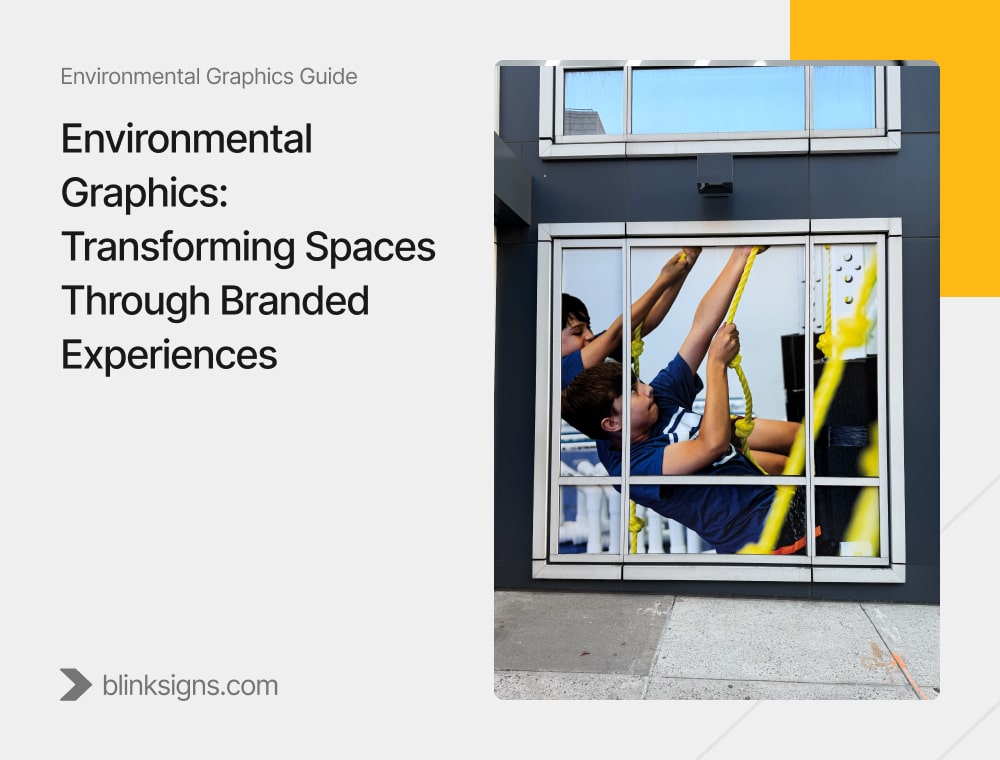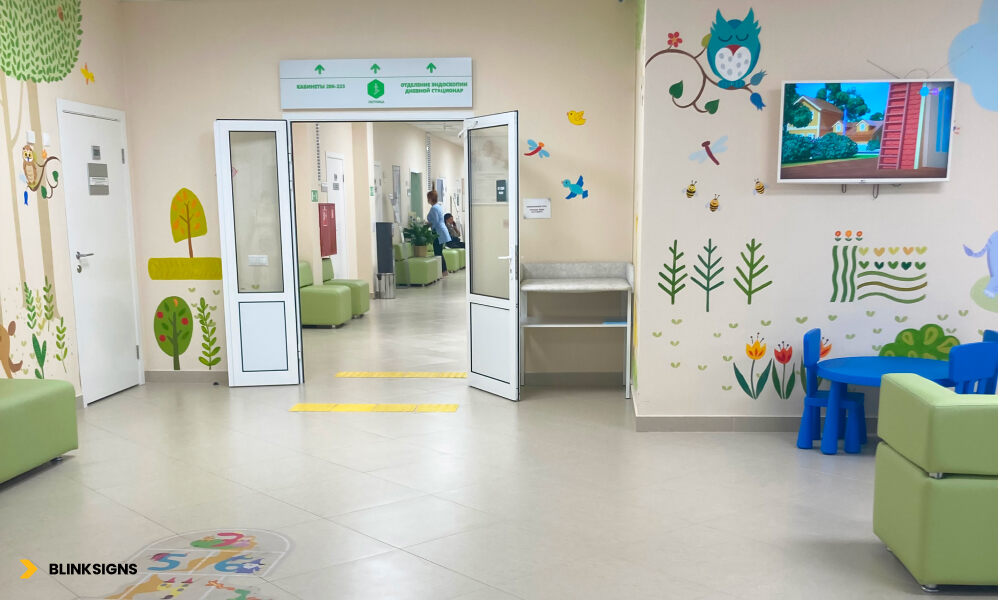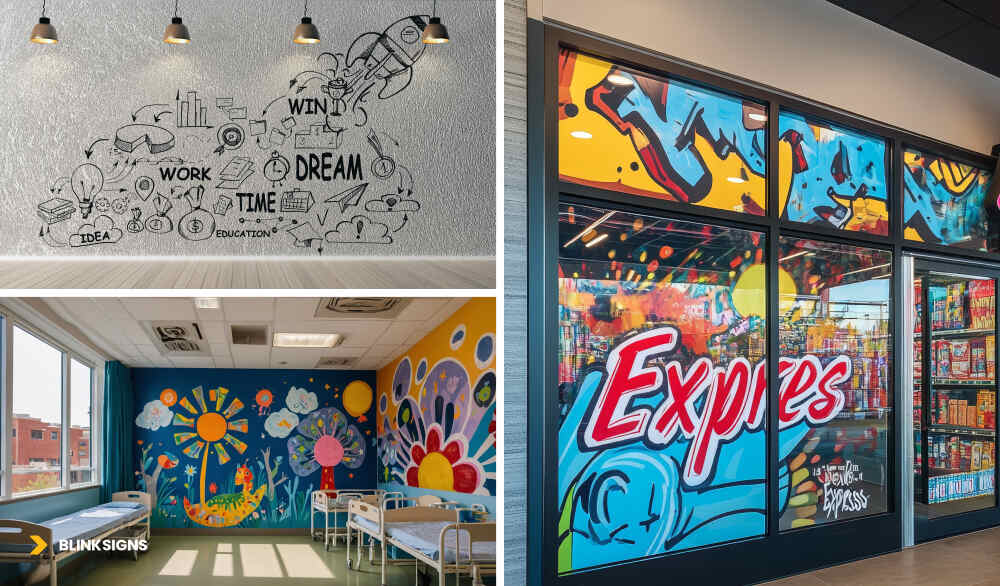
Environmental Graphics: Transforming Spaces Through Branded Experiences
Walking into a well-designed space often feels different long before you realize why. Colors guide your attention. Patterns create rhythm. Messages appear precisely where you need them. Every wall, floor, and directional cue quietly reinforces the brand without overwhelming you. The result is the power of environmental graphics.
Many businesses underestimate the significant impact their physical environment has on how people feel and behave. Customers make decisions based on emotional responses within a space, not just on the visual identity printed on a sign. Employees form impressions of the workplace from the instant they enter the lobby. Visitors rely on wayfinding cues that shape their entire experience.
When environmental graphics are executed strategically, a space becomes a branded journey that strengthens identity, improves navigation, and elevates trust.
BlinkSigns has seen firsthand how businesses transform when walls, corridors, ceilings, windows, and other structural elements become purposeful touchpoints. This transformation is not about decoration. It is a meaningful shift that aligns a brand’s message with the space where people interact with it.
What Are Environmental Graphics

Environmental graphics
Environmental graphics combine visual communication, architectural context, and branded storytelling inside physical spaces. The goal is to shape how people experience a location through purposeful design.
Every graphic, directional sign, dimensional letter, digital element, or branded message becomes part of a larger environment that reflects the organization’s identity.
This discipline blends architecture, graphic design, interior design, brand psychology, and user experience. The result is a cohesive system that influences movement, emotion, and perception. Environmental graphics encompass a range of elements, including murals and wayfinding systems, which, when applied across multiple locations, become a powerful tool for brand consistency.
BlinkSigns approaches environmental graphics as a whole ecosystem. This includes a thoughtful assessment of the building layout, lighting, materials, accessibility standards, and long-term maintenance needs. Brands receive more than graphics. They receive a structured environmental experience that feels intentional and aligned with their goals.
Why Environmental Graphics Matter for Brands
A physical space is one of the most influential parts of brand perception. Customers judge credibility based on the quality of the environment they walk into. Employees feel motivated when their workplace reflects the mission they contribute to.
Visitors develop trust when they find it easy to navigate through the site. Environmental graphics elevate these experiences with a blend of emotion, clarity, and identity.
Brands gain measurable benefits through intentional environmental design. People tend to stay longer in spaces that feel visually guided and emotionally comfortable. Visitors feel less stressed when wayfinding is intuitive. When a business consistently expresses its identity across every touchpoint within the building, customers form stronger memory associations.
Environmental graphics also support brand storytelling. Wall graphics help communicate purpose and culture. Dimensional letters establish presence. Material choices send signals about sustainability and values. Even small design elements, such as directional arrows or numbering systems, can significantly influence how people perceive and feel within the space.
BlinkSigns has observed that organizations with well-developed environmental graphics gain stronger customer loyalty, improved employee morale, and better spatial efficiency. A clear, branded environment can reduce navigation errors, shorten visitor wait times, and support ADA-compliant wayfinding. These benefits create a more professional, unified experience for anyone who interacts with the space.
Key Applications and Use Cases

Key Applications and Use Cases of Environmental graphics
Environmental graphics are utilized in a diverse range of environments, each with its own distinct objectives.
A corporate office needs brand alignment and employee inspiration. A hospital requires clear wayfinding and calming visuals. A retail store needs visual storytelling that influences buyer behavior.
Each type of space benefits differently from environmental graphics.
Corporate Interiors
Modern workplaces rely heavily on environmental graphics to foster a strong culture. Lobbies, conference rooms, hallways, and collaboration zones become branded storytelling areas. Murals, mission statements, dimensional logos, and color-based zoning help employees feel a sense of connection to the organization. These visuals also impress clients and reinforce professionalism.
Retail and Hospitality
Retail environments benefit from eye-catching visuals that capture attention, guide the flow, and enhance dwell time. Environmental graphics help define zones, highlight products, and build emotional engagement. Hospitality spaces use branded themes to create memorable atmospheres that encourage return visits.
Healthcare and Educational Facilities
Hospitals, clinics, and campuses need highly functional graphics. Clear wayfinding reduces confusion, while color coding helps visitors navigate departments effectively. Calming themes lower anxiety. Educational spaces use creative graphics for inspiration, identity, and improved navigation.
Events, Exhibits, and Public Spaces
Large venues rely on environmental graphics for flow management and experience design. Walls, floors, temporary structures, and interactive installations become components of a larger story. These environments require bold visuals, fast comprehension, and durable materials.
Multi-Site Rollouts for Franchises and Enterprises
Brands with multiple locations need consistency across states, cities, and building types. Environmental graphics standardize the experience. BlinkSigns supports regional permitting, brand compliance, material selection, and scalable production so each location feels familiar and aligned with the brand’s identity.
Environmental graphics turn functional spaces into brand assets. They help organizations communicate who they are without needing to say a word.
Design and Implementation Best Practices
Businesses gain the most value from environmental graphics when design and execution follow a structured, experience-first approach. Strong visuals alone do not create a branded environment.
The actual impact stems from the alignment of strategy, user behavior, material choices, lighting, placement, compliance, and the quality of installation.
Start with Spatial Strategy
Every space has a rhythm, even when it feels ordinary at first glance. Environmental graphics must support this rhythm rather than overpower it. The first step is to review floor plans, traffic patterns, focal points, and decision areas where people stop or turn.
The goal is to understand how individuals move through the environment and what guidance they need along the way. This strategic step prevents designs that feel decorative instead of purposeful.
Align Visuals with Brand Identity
Branded environments are most effective when the graphics accurately reflect the brand’s voice and values. Color palettes, typography, textures, and patterns must remain consistent across all surfaces.
A strong environmental graphics program ensures that visitors can recognize the brand without needing to see the logo. This creates emotional continuity and reinforces trust.
Use ADA-compliant and Human-Centered Wayfinding
Wayfinding must be clear enough to reduce decision fatigue. Many organizations underestimate the stress that navigating their websites can cause for visitors.
When signs are appropriately sized, positioned, illuminated, and placed with ADA alignment, users move confidently and make fewer mistakes. This reduces staff interruptions and improves the overall experience.
Choose Materials for Longevity and Sustainability
Material selection shapes both the quality and sustainability of a branded environment. Acrylic, aluminum, PVC-free films, sustainable woods, dimensional letters, and high-performance wall coverings all play a role in this process.
BlinkSigns guides brands toward options that match their durability needs, maintenance expectations, and environmental goals.
Plan for Multi-Site Consistency
National and regional brands face unique challenges. Every location must feel familiar, even when building layouts differ. Consistency reduces cognitive load and strengthens recognition.
BlinkSigns supports this through standardized specs, branded design systems, and permitting guidance that adapts to local regulations without compromising identity.
Integrate Digital and Interactive Elements
Digital displays, LED walls, sensor-based experiences, projection mapping, and interactive screens extend the story beyond static graphics, creating a more immersive experience.
These technologies enhance engagement and allow brands to update content without reconstruction. Proper integration requires power planning, mounting solutions, and thoughtful placement to ensure clarity and safety.
Focus on Lifecycle, Maintenance, and Upkeep
Environmental graphics should last. Durability varies depending on factors such as foot traffic, sunlight exposure, cleaning frequency, and building usage.
BlinkSigns helps organizations plan for lifecycle management, ensuring their environment looks fresh year after year. This includes reprints, updates for rebranding, and maintenance of digital elements.
Environmental Graphics Material Options and Best Use Cases
Below is a comprehensive comparison table that helps brands understand where each material fits within a real environment. It includes terminology that aligns with BlinkSigns services.
| Material Type | Best Use Case | Durability Level | Indoor or Outdoor | Ideal Brand Application | Maintenance Requirements | Sustainability Notes |
| High-Performance Wall Vinyl | Large murals, brand storytelling walls, directional graphics | High | Indoor | Corporate interiors, retail environments, clinics, campuses | Easy to clean, resistant to fading | PVC-free options available |
| Acrylic Panels | Lobby statements, dimensional logos, feature walls | Very High | Indoor | Corporate reception areas, showrooms | Wipe with non-abrasive cleaners | Recyclable, long-lasting |
| Aluminum Composite Panels | Exterior branding, high-visibility identity areas | Very High | Outdoor | Building exteriors, drive-thru structures, hospitality | Weather-resistant, minimal upkeep | Long lifespan reduces waste |
| PVC-Free Films | Sustainable indoor graphics, window visuals | Medium | Indoor | Eco-conscious brands, educational institutions | Replace every few years, depending on exposure | Eco-friendly alternative |
| Dimensional Letters (Foam, Metal, Acrylic) | High-impact identity elements, nameplates | High | Indoor and outdoor | Offices, retail, healthcare | Occasional dusting and surface cleaning | Acrylic and metal options are recyclable |
| Illuminated Signage Components | Feature walls, directional lighting, and branded atmospheres | Very High | Indoor and outdoor | Retail chains, entertainment venues, hospitality | Requires electrical maintenance | Energy-efficient LED options |
| Wood Textured Substrates | Warm branded interiors, premium retail | Medium | Indoor | Hospitality, boutique retail, offices | Avoid moisture exposure | Options available in sustainable woods |
| Digital Display Screens | Dynamic storytelling, real-time updates, and queue management | Very High | Indoor | Multi-site enterprises, healthcare, events | Software updates and cleaning | Reduces printed material waste |
How to Measure Impact and ROI

Impact of Environmental Graphics
Environmental graphics influence behavior and perception. When a business invests strategically, these visuals improve performance at multiple levels. Measuring impact helps brands understand how their environment contributes to their success.
Key Metrics for Evaluation
Visitor Movement Efficiency
Monitor navigation errors, repeated questions, and average time spent locating key areas. Clear wayfinding reduces confusion and saves staff time.
Dwell Time and Emotional Engagement
Retail and hospitality spaces often see longer dwell times in visually appealing zones. Higher dwell time increases the opportunity for engagement and conversion.
Brand Recall and Identity Recognition
Branded environments improve memory retention. When visitors remember the space, they remember the brand.
Staff Productivity
Workplaces with branded graphics report improved focus, motivation, and internal alignment. A well-organized environment reduces mental friction.
Customer Satisfaction Scores
Straightforward navigation, calming visuals, and consistent identity contribute directly to guest satisfaction.
Qualitative Feedback Channels
- Employee interviews
- Visitor surveys
- Mystery shopper assessments
- Post-installation evaluations
- Operational observations
Why ROI Matters
Environmental graphics are long-term assets. They refresh environments without major renovation. They support brand communication, improve navigation, reduce staff workload, and enhance customer perception.
When a company invests in well-designed graphics, it gains a measurable advantage that supports revenue and loyalty.
Frequently Asked Questions
1. What are environmental graphics
Environmental graphics are visual elements that shape how people experience a physical space. These include wall graphics, wayfinding systems, dimensional letters, murals, window films, and digital displays. The goal is to improve navigation, reinforce brand identity, and create a more engaging environment.
2. How do environmental graphics benefit my business
A branded environment enhances customer perception, fosters employee motivation, and reinforces brand recognition. It reduces navigation stress, increases dwell time, and fosters an atmosphere that aligns with the organization’s values.
3. Where are environmental graphics used
They are used in corporate interiors, retail stores, hospitals, educational campuses, hospitality spaces, public venues, events, and multi-site franchise locations. Each space benefits differently based on goals such as wayfinding, inspiration, storytelling, or visual impact.
4. What is the difference between environmental graphics and traditional signage
Traditional signage focuses on individual signs. Environmental graphics focus on the entire environment. This approach ensures that every graphic element works together to create a consistent and memorable brand experience.
5. What materials are commonly used for environmental graphics
Brands can choose from high-performance vinyl, acrylic panels, metal substrates, dimensional letters, PVC-free films, wood textures, and digital screens. The selection depends on durability needs, brand style, sustainability goals, and installation conditions.
6. Are environmental graphics suitable for multi-site or national rollouts
Yes. Environmental graphics are ideal for multi-location brands because they ensure consistent identity across different building layouts. BlinkSigns offers standardized design packages, production quality control, and permitting support tailored to each state or region.
7. Can environmental graphics support ADA compliance
Yes. Wayfinding graphics and signage can be designed to align with ADA requirements. This includes typography size, tactile lettering, Braille, color contrast, lighting placement, and installation height.
8. How long do environmental graphics last
Durability depends on both the materials used and the ecological conditions in which they are applied. Indoor wall graphics can last several years with minimal maintenance. Exterior-grade panels and dimensional signs have longer lifespans. Regular upkeep keeps everything looking fresh.
9. Can digital displays be integrated with environmental graphics
Yes. Digital screens, LED walls, and interactive technology add motion and real-time content to the environment. These elements enhance storytelling and allow brands to update visuals without reprinting materials.
10. How do I start an environmental graphics project with BlinkSigns
The process begins with a consultation. BlinkSigns reviews your space, brand identity, goals, and user flow. After the strategy phase, the team designs, produces, and installs graphics that transform your environment into a cohesive brand experience.
Getting Started with BlinkSigns
BlinkSigns simplifies the environmental graphics journey for organizations of all sizes. Brands receive guidance from concept to installation.
The process begins with a consultation that reviews goals, layout, brand identity, and performance needs. The design team then develops visuals that complement the space while authentically representing the brand.
Production is carried out using high-performance materials and industry-tested fabrication methods. Installation teams ensure accuracy, safety, and the longevity of the installation.
For multi-site rollouts, BlinkSigns coordinates package standardization, compliance requirements, and shipping logistics to keep every location aligned with brand standards.
Organizations seeking to transform their environments can request a site audit, brand alignment review, or a comprehensive environmental graphics package. BlinkSigns helps turn every wall, corridor, and surface into a strategic expression of identity.